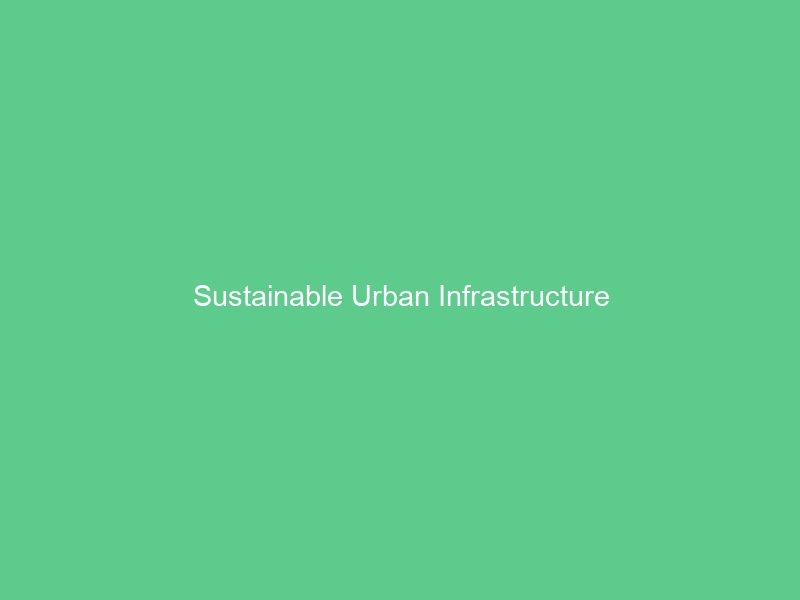Sustainable urban infrastructure involves equipment and structures that are eco-friendly from beginning to end, such as equipment used in recycling programs or structures designed to promote biodiversity in their area. Such infrastructure can serve multiple functions, including decreasing pollution levels and expanding local biodiversity.
Initiatives are underway in various cities to reduce greenhouse gas emissions and rising temperatures, including revitalizing public spaces for non-motorized transport, employing energy-saving building techniques and planting green roofs.
Nature-based infrastructure (NBI)
NBI provides an effective and cost-efficient alternative to conventional grey infrastructure, offering several co-benefits that include climate change mitigation, habitat support and recreational space. Furthermore, its implementation enables other sustainable investments like mobility, water and energy systems.
To maximize the full benefits of NBI, it must be integrated into city planning and project assessments. This requires planners, policy-makers and budget holders to adopt an systematic evaluation process when selecting which NBI projects will support infrastructure needs or sustainability objectives in their city.
At COP26, the International Institute for Sustainable Development (IISD) launched its Nature-Based Infrastructure Global Resource Centre alongside GEF Special Climate Change Fund, MAVA Foundation and UNIDO. It offers data, training courses and customized valuations of NBI opportunities and related co-benefits using state-of-the-art systems thinking and financial modelling techniques – aiding governments, companies and private investors make more informed decisions on how best to finance and implement NBI projects.
Public spaces
Public spaces are essential to the sustainability of cities, providing many social and economic advantages. Public spaces support community involvement, cultural events, commerce, recreation areas and recreational use; whether natural or built, great places are accessible and encourage interaction among residents; providing amenities for passive recreation or socialization, encouraging community spirit while still being safe and well maintained.
Urban infrastructure includes power supplies, sewage systems, clean water distribution networks and transportation networks in a city. To be sustainable infrastructure solutions that meet both present and future generations while simultaneously minimizing environmental impacts.
Many solutions to climate change rely on nature for solutions, including turning cement and tarmac surfaces into absorbent green areas such as Sao Paulo’s Yangtze River park – this can also help mitigate its adverse effects such as flooding and urban heat island effect.
Renewable energy
Sustainable urban infrastructure allows cities to enhance resilience, decrease carbon emissions and promote community sustainability. Implementing green technologies into transportation systems, public spaces and energy production contributes to environmental health, enhance quality of life and spur economic development.
Renewable energy is a key element of sustainable urban infrastructure, yet the technology presents several obstacles, such as intermittency and high upfront costs. To overcome these hurdles, renewable sources should be combined or storage technologies utilized to cover any supply gaps in energy supply.
Cities are well suited to support renewable energy. Acting as energy planners and regulators, cities can establish policies which promote more eco-friendly technologies while discouraging consumption of unsustainable practices. They also can ease transition to renewables through offering financial incentives like municipal green bonds or low-interest loans – or using their position as major energy consumers to acquire renewable energy certificates through public-private partnerships with global renewable energy providers.
Transportation
Transportation is an integral component of urban infrastructure, providing access to jobs, education and other essential services as well as building community bonds and cultural exchange. Unfortunately, transportation can also contribute significantly to air pollution and land use changes; therefore, its environmental impact must be carefully considered when developing sustainable urban infrastructure solutions.
Cities can significantly decrease transportation-related carbon emissions by encouraging public transit and rerouting traffic to ease congestion. They could also encourage higher-density development near transit lines and hubs so as to minimize travel requirements – this strategy may even promote exercise for added health benefits!
An essential feature of sustainable urban infrastructure is its capacity to adapt to future needs. To meet demand without overstretching resources, cities need networks with sufficient capacity. Furthermore, sustainable designs should incorporate natural elements like greenspace and water bodies to combat climate change while increasing resilience and combatting resilience gaps.

